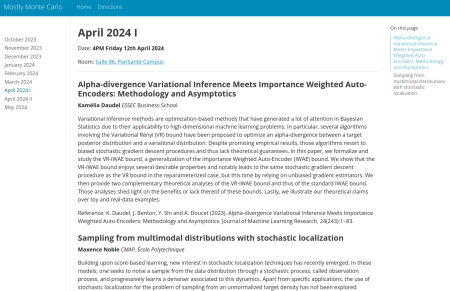Archive for Bayesian computational methods
Xuriouser & Xuriouser
Posted in Books, Statistics with tags accept, Bayesian computational methods, cross validated, Metropolis-Hastings algorithms, Monte Carlo Statistical Methods, normalising constant, principle of proportionality, screenshot, simulation on May 8, 2024 by xi'anMCMC without evaluating the target [aatB-mMC joint seminar, 24 April]
Posted in pictures, Statistics, Travel, University life with tags All about that Bayes, Balard, Bayesian computational methods, doubly intractable problems, exchange algorithm, intractable likelihood, MCMC, mostly Monte Carlo seminar, normalising constant, PariSanté campus, Porte de Versailles, Rutgers University, sampling, seminar on April 11, 2024 by xi'an On 24 April 2024, Guanyang Wang (Rutgers University, visiting ESSEC) will give a joint All about that Bayes – mostly Monte Carlo seminar on
On 24 April 2024, Guanyang Wang (Rutgers University, visiting ESSEC) will give a joint All about that Bayes – mostly Monte Carlo seminar on
MCMC when you do not want to evaluate the target distribution
In sampling tasks, it is common for target distributions to be known up to a normalizing constant. However, in many situations, evaluating even the unnormalized distribution can be costly or infeasible. This issue arises in scenarios such as sampling from the Bayesian posterior for large datasets and the ‘doubly intractable’ distributions. We provide a way to unify various MCMC algorithms, including several minibatch MCMC algorithms and the exchange algorithm. This framework not only simplifies the theoretical analysis of existing algorithms but also creates new algorithms. Similar frameworks exist in the literature, but they concentrate on different objectives.
The talk takes place at 4pm CEST, in room 8 at PariSanté Campus, Paris 15.
mostly MC [April]
Posted in Books, Kids, Statistics, University life with tags #ERCSyG, Bayesian computational methods, Bayesian inference, denoising, generative models, Institut PR[AI]RIE, JMLR, machine learning, Markov chain Monte Carlo, MCMC, Monte Carlo methods, Monte Carlo Statistical Methods, mostly Monte Carlo seminar, multimodal target, Ocean, optimization, Paris, PariSanté campus, PSC, sampling, score-based generative models, seminar, simulation, stochastic diffusions, stochastic localization, variational autoencoders on April 5, 2024 by xi'anhistories of sign languages
Posted in Books, Statistics, University life with tags AAAS, American, Austrian, Bayesian computational methods, British, Chinese, computational phylogenetics, Czech, deaf people, Edinburgh, Estonian, French, German, Hong Kong, Italian, Japanese, language history, Latvian, Lithuanian, MCMC, Monte Carlo Statistical Methods, New Zealand, phylogenetic models, phylogenetic tree, Polish, Russian, Science, Scotland, sign language, Spanish, Taiwan, Ukrainian on February 8, 2024 by xi'an Congrats to Grégoire Clarté (now in Edinburgh) and Robin Ryder who, along with coauthors from several instutions, published an article in Science this week about the philogenetic tree of (Asian and European) sign languages for the deaf people. Part of Grégoire’s thesis contained preliminary work on this problem.
Congrats to Grégoire Clarté (now in Edinburgh) and Robin Ryder who, along with coauthors from several instutions, published an article in Science this week about the philogenetic tree of (Asian and European) sign languages for the deaf people. Part of Grégoire’s thesis contained preliminary work on this problem.
Abstract
Sign languages are naturally occurring languages. As such, their emergence and spread reflect the histories of their communities. However, limitations in historical recordkeeping and linguistic documentation have hindered the diachronic analysis of sign languages. In this work, we used computational phylogenetic methods to study family structure among 19 sign languages from deaf communities worldwide. We used phonologically coded lexical data from contemporary languages to infer relatedness and suggest that these methods can help study regular form changes in sign languages. The inferred trees are consistent in key respects with known historical information but challenge certain assumed groupings and surpass analyses made available by traditional methods. Moreover, the phylogenetic inferences are not reducible to geographic distribution but do affirm the importance of geopolitical forces in the histories of human languages.

